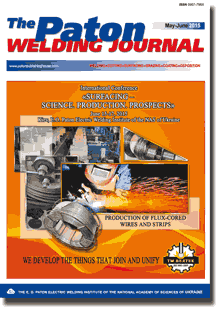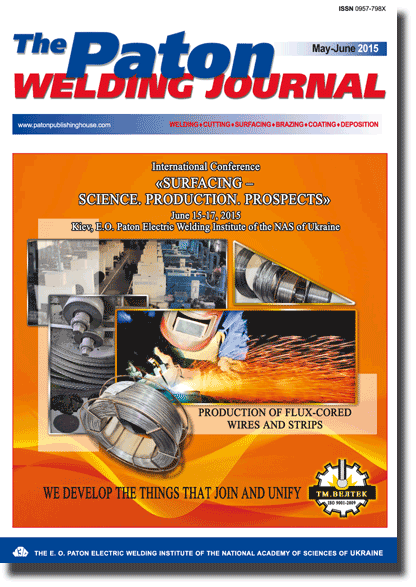| 2015 №06 (11) |
DOI of Article 10.15407/tpwj2015.06.12 |
2015 №06 (13) |

The Paton Welding Journal, 2015, #5-6, 52-54 pages
Peculiarities of fire-cracker plate electrode arc surfacing over alloying charge
I.A. Bartenev
Karaganda State Technical University. 56 Mir Bld., 100027, Karaganda, Kazakhstan. E-mail: igor_svar@mail.ru
Abstract
The method of arc surfacing of flat parts using fire-cracker plate electrode over alloying charge was offered. The main factors determining stability of surfacing process are the following: arc voltage U, arc current I, and electrode sectional area S. As a result of experiments the range of surfacing current (300-400 A) was determined providing stability of mode at the start and throughout the whole process of surfacing. It was established that hardness of deposited metal amounted to HRC 47-52, which is higher than that of metal such as steel G13. Metallographic investigations showed that the offered method provides a minimal penetration of base metal, that will allow obtaining the necessary chemical composition of deposited metal in single-layer surfacing. 4 Ref., 2 Tables, 3 Figures.
Keywords: arc surfacing, alloying charge, plate electrode, hardness of deposited metal, penetration
Received: 20.04.15
Published: 28.07.15
References
1. Vlasov, V.M. (1987) Serviceability of reinforced friction surfaces. Moscow: Mashinostroenie.
2. Livshits, L.S., Grinberg, N.A., Kurkumelli, E.G. (1969) Principles of alloying of deposited metal. Moscow: Mashinostroenie.
3. Frumin, I.I. (1961) Automatic electric arc surfacing. Kharkov: Metallurgizdat.
4. Ryabtsev, I.A., Kondratiev, I.A. (1999) Mechanized electric arc surfacing of metallurgical equipment parts. Kiev: Ekotekhnologiya.
Suggested Citation
I.A. Bartenev (2015) Peculiarities of fire-cracker plate electrode arc surfacing over alloying charge. The Paton Welding J., 06, 52-54.The cost of subscription/purchase order journals or individual articles
| Journal/Currency | Annual Set | 1 issue printed |
1 issue |
one article |
| TPWJ/USD | 384 $ | 32 $ | 26 $ | 13 $ |
| TPWJ/EUR | 348 € | 29 € | 24 € | 12 € |
| TPWJ/UAH | 7200 UAH | 600 UAH | 600 UAH | 280 UAH |
| AS/UAH | 1800 UAH | 300 UAH | 300 UAH | 150 UAH |
| AS/USD | 192 $ | 32 $ | 26 $ | 13 $ |
| AS/EUR | 180 € | 30 € | 25 € | 12 € |
| SEM/UAH | 1200 UAH | 300 UAH | 300 UAH | 150 UAH |
| SEM/USD | 128 $ | 32 $ | 26 $ | 13 $ |
| SEM/EUR | 120 € | 30 € | 25 € | 12 € |
| TDNK/UAH | 1200 UAH | 300 UAH | 300 UAH | 150 UAH |
| TDNK/USD | 128 $ | 32 $ | 26 $ | 13 $ |
| TDNK/EUR | 120 € | 30 € | 25 € | 15 € |
AS = «Automatic Welding» - 6 issues per year;
TPWJ = «PATON WELDING JOURNAL» - 12 issues per year;
SEM = «Electrometallurgy Today» - 4 issues per year;
TDNK = «Technical Diagnostics and Non-Destructive Testing» - 4 issues per year.


